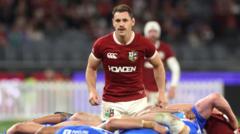Is Williams Out of the Lions Tour? Meet White, His Replacement!

Understanding Hamstring Injuries in Professional Rugby
Hamstring injuries are a common setback for athletes, particularly in high-impact sports like rugby. When Wales scrum-half Tomos Williams suffered a hamstring injury during the British and Irish Lions tour, it highlighted the vulnerability of even the most talented players. This article will explore the nature of hamstring injuries, their implications for athletes, particularly rugby players, and the broader context of injury management in professional sports.
The Nature of Hamstring Injuries
The hamstring is a group of three muscles located at the back of the thigh: the biceps femoris, semitendinosus, and semimembranosus. These muscles play a crucial role in various movements, including running, jumping, and sudden direction changes—all vital actions in rugby.
Types of Hamstring Injuries
Hamstring injuries can be classified into three grades:
- Grade 1 (Mild): This involves minor strains where only a few muscle fibers are damaged. Symptoms might include slight pain and stiffness.
- Grade 2 (Moderate): This grade involves a more significant tear, resulting in more intense pain, swelling, and some loss of strength.
- Grade 3 (Severe): A complete rupture of the muscle, which can lead to severe pain, swelling, and a complete loss of function in the affected leg.
Tomos Williams' injury is not explicitly graded in reports, but given its impact on his ability to continue in the Lions tour, it suggests a moderate to severe injury.
Causes of Hamstring Injuries in Rugby
Several factors contribute to the risk of hamstring injuries in rugby:
High-Intensity Demands
Rugby is characterized by bursts of high-intensity activity, including sprinting and sudden changes in direction. These actions put immense strain on the hamstring muscles, increasing the likelihood of injury.
Fatigue
As matches progress, athletes experience fatigue, which can lead to compromised muscle function and coordination, making injuries more likely.
Poor Preparation and Conditioning
Inadequate warm-ups, insufficient stretching, and lack of strength training can all contribute to the risk of hamstring injuries. Professional teams typically have rigorous conditioning programs to mitigate these risks.
Impact of Hamstring Injuries on Athletes
The implications of hamstring injuries extend beyond immediate pain and discomfort. For professional athletes like Tomos Williams, such injuries can mean:
- Time Away from Competition: Injuries can sideline players for weeks, affecting their playing time and overall career trajectory.
- Psychological Effects: The fear of reinjury can lead to anxiety and a lack of confidence in performance.
- Team Dynamics: Injuries can alter team strategies, as coaches must adjust their line-ups and game plans.
Williams’ departure from the Lions tour not only affects his career but also alters the team’s dynamics, leaving only one remaining Welshman in the squad, flanker Jac Morgan.
Rehabilitation and Recovery
Recovering from a hamstring injury involves a multifaceted approach:
Initial Management
Immediate treatment typically follows the R.I.C.E. principle:
- Rest: Avoiding any activity that exacerbates the injury.
- Icing: Applying ice packs to reduce swelling and pain.
- Compression: Using elastic bandages to minimize swelling.
- Elevation: Keeping the injured limb elevated to reduce swelling.
Physical Therapy
Once the initial pain subsides, physical therapy is crucial. This may include:
- Stretching Exercises: To restore flexibility and range of motion.
- Strength Training: To rebuild muscle strength.
- Functional Drills: To improve coordination and prepare for return to sport.
Gradual Return to Play
The transition back to full participation must be gradual and carefully monitored. Athletes should not rush this process, as premature return can lead to re-injury.
The Role of Sports Medicine in Injury Prevention
Sports medicine plays a critical role in preventing injuries like those suffered by Tomos Williams. Key strategies include:
Pre-Season Conditioning
Thorough pre-season training regimens help prepare athletes for the physical demands of the sport. This includes strength training, flexibility exercises, and conditioning drills.
In-Season Monitoring
Regular assessments can help identify players at risk of injury, allowing for timely interventions.
Education on Injury Prevention
Coaches and athletes benefit from education on proper warm-up techniques, recovery protocols, and the importance of listening to their bodies.
The Future of Tomos Williams and the Welsh Team
Williams’ injury is undeniably a blow to both him and the Welsh team. It raises questions about not only his recovery and return to the sport but also the future of the Welsh squad in the ongoing Lions tour.
As Ben White steps in to replace Williams, the dynamics of the team will shift. This situation serves as a reminder of the importance of depth in squad composition and the need for all players to be prepared to step up when called upon.
Conclusion
Injuries are an unfortunate reality in professional sports, but understanding them can help mitigate their impacts. For players like Tomos Williams, recovery from a hamstring injury involves a careful blend of medical intervention, rehabilitation, and psychological support. As the Lions tour continues, it will be interesting to see how the team adapts and overcomes this setback.
FAQs
What is a hamstring injury?
A hamstring injury involves damage to one or more of the muscles at the back of the thigh, often resulting from overstretching or excessive strain during physical activities.
How long does it take to recover from a hamstring injury?
The recovery time varies based on the severity of the injury. Mild strains may heal within a few weeks, while more severe injuries can take several months to fully recover.
How can athletes prevent hamstring injuries?
Preventative measures include proper warm-ups, strength training, flexibility exercises, and fatigue management to minimize the risk of injury.
As we follow the journey of players like Tomos Williams, it's crucial to appreciate the resilience and dedication required to overcome such challenges in professional sports. How do you think teams can better support players through their recovery processes? #RugbyInjury #HamstringHealth #SportsRecovery
Published: 2025-06-30 01:29:08 | Category: sport



